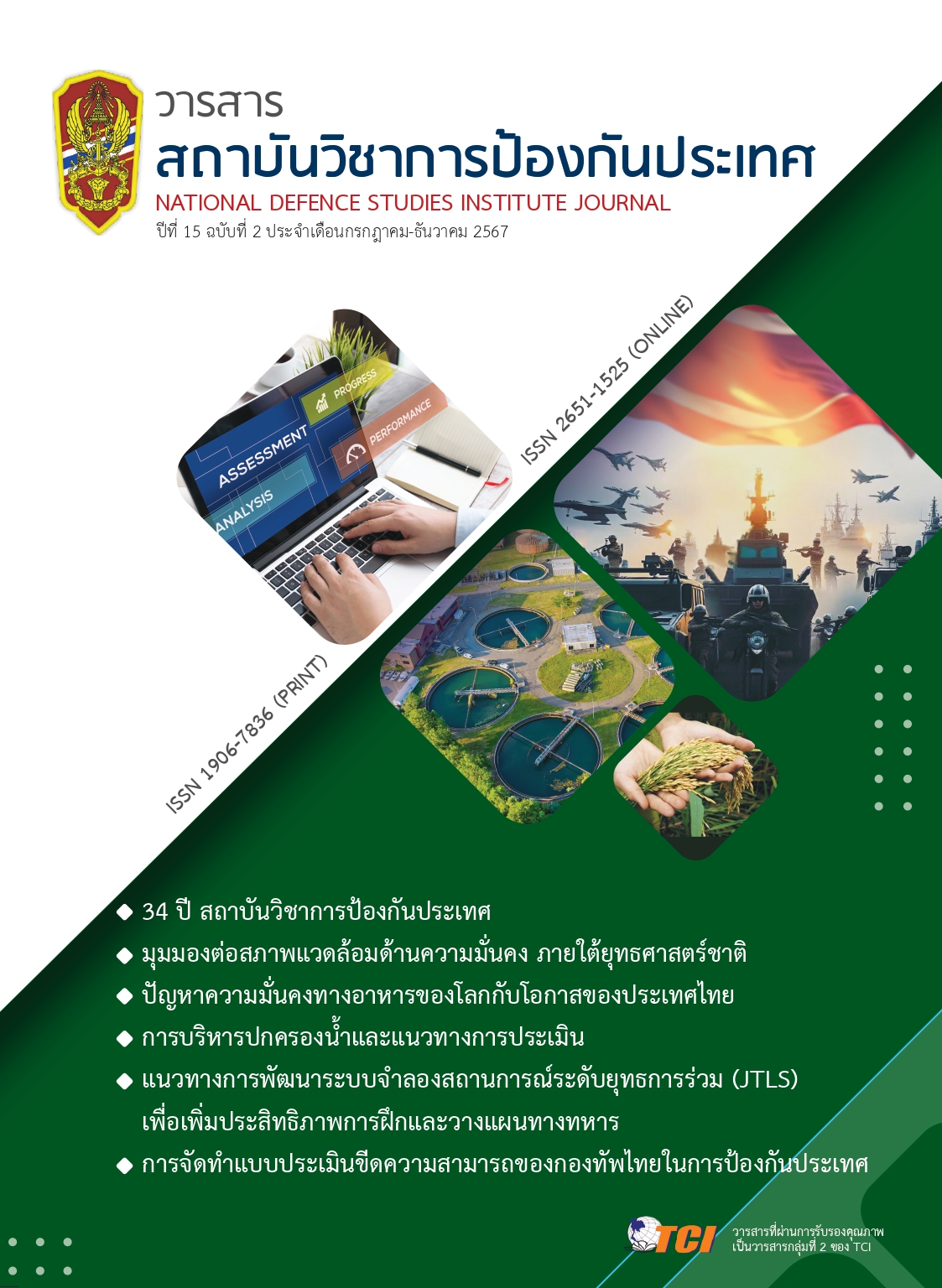Approaches for Developing Joint Theater Level Simulation (JTLS) to Enhance Military Training and Planning Efficiency
Main Article Content
Abstract
This article presents approaches for developing the Joint Theater Level Simulation (JTLS) system to enhance military training and planning efficiency. The focus is on improving simulation realism, increasing processing efficiency, and accommodating modern military scenarios. The study covers key aspects including the enhancement of mathematical and physical models, increasing the detail of environmental and terrain simulation, application of modern technologies such as AI, Big Data, VR, and AR, development of connectivity and interoperability with other systems, and improvement of user interfaces. Furthermore, the article discusses challenges in data security, resource and budget management, as well as personnel training. It also presents future trends and directions for JTLS development to accommodate technological changes and evolving military situations. The conclusion emphasizes the importance of continuous and integrated development of JTLS to strengthen military readiness and national security in an era of complex and rapidly changing strategic challenges.
Article Details

This work is licensed under a Creative Commons Attribution-NonCommercial-NoDerivatives 4.0 International License.
The articles, images, tables, graphs, written content, and opinions published in this journal are solely those of the authors and do not necessarily reflect the views or positions of the National Defence Studies Institute or its academic affiliates.
References
Alim, H., Subramaniam, A., Mohamad Nor, N., & Abd Wahab, A. Y. (2024). Measuring operational cognitive readiness of military personnel using Joint Theater Level Simulation System (JTLS). The Journal of Defense Modeling and Simulation: Applications, Methodology, Technology. https://doi. org/10.1177/15485129241239669
Artkin, F. (2022). Obtaining of the Modal Frequency Parameters a Middle Class Armed Unmanned Combat Aerial Vehicle Using Engineering Simulation ANSYS Program. European Journal of Science and Technology. 2022(45), 14-18. https://doi.org/10.31590/ejosat.1211104
Barbosa, J. (2020). Cyber Humanity in Cyber War. In Proceedings of the 19th European Conference on Cyber Warfare and Security, (p.20). https://doi.org/10.34190/ews.20.116
Bayramov, A. A., & Hashimov, E. G. (2019). Development of UAV SOS Flight Combat Reconnaissance Mission Program. Advanced Information Systems, 3(1), 152-156. https://doi.org/10.20998/2522-9052.2019.1.25
Blaess, S. G., Christie, M. J., & Mitchell, J. L. (2021). Comet: A naval Combat Management System model for combat analysis. In R. W. Vervoort, A. A. Voinov, J. P. Evans, & L. Marshall (Eds.), 24th International Congress on Modelling and Simulation (p.855-861). https://doi.org/10.36334/modsim.2021.m7.blaess
Brown, T. L. (1991). America’s war: the strategy and tactics of the United States’ military in Vietnam. In T. L. Brown (Ed.), War and Aftermath in Vietnam. London: Routledge. https://doi.org/10.4324/9781003244257-9
Chau, W., Grill, A., & Grieger, D. (2017). Using combat simulation and sensitivity analysis to support evaluation of land combat vehicle configurations. In G. Syme, D. H. MacDonald, B. Fulton, & J. Piantadosi (Eds.)., 22nd International Congress on Modelling and Simulation (p.536-542). https://doi.org/10.36334/modsim.2017.d1.chau
Fidler, D. P. (2022). Cyber war. In Advanced Introduction to Cybersecurity Law (p.104-141). https://doi. org/10.4337/9781800883352.ch006
Godefroy, A. B. (2015). Atomic War Games: Combat Development through Simulation, 1958–64. In Peace Prepared: Innovation and Adaptation in Canada’s Cold War Army (p.151-185). University of British Columbia Press. https://doi.org/10.59962/9780774827041-009
Hibberd, G. (2022). Rewards of War. In The Art of Cyber Security: A practical guide to winning the war on cyber crime (p.123-128). https://doi.org/10.2307/j.ctv2hqrdb4.19
Hou, Q., & Yao, Y. (2018). Research on Modeling Maritime Patrol Behavior of Aircraft on Station in Theater- Level Operation Simulation. DEStech Transactions on Computer Science and Engineering.
Kozlov, S. N. (1982). Development of Soviet Military Science After the Second World War. In H. F. Scott, & W. F. Scott (Eds.), The Soviet Art of War. New York: Routledge. https://doi.org/10.4324/9780429314681-20
Lee, H. J., Choi, S.H., Yoo, H. D., Koo, J., & Kim, T. G. (2017). Development Of Air Combat HDEVS Model Implemented In HDEVSim++ Environment. In SummerSim’ 17: Proceeding of the Summer Simulation Multi-Conference (p.1-12). San Diego, CA: Society for Computer Simulation International. https://doi.org/10.22360/summersim.2017.scsc.011
Lekwilai, P. (2014). Reader’s Theater: An Alternative Tool to Develop Reading Fluency among Thai EFL learners. PASAA, 48(1), 89-112. https://doi.org/10.58837/chula.pasaa.48.1.4
Levin, H., & Cheng, A. (2020). Curriculum Integration and Development. In M. A. Seropian, G. R. Keeler, & V. N. Naik (Eds.). Comprehensive Healthcare Simulation: Program & Center Development (p.83-87). https://doi.org/10.1007/978-3-030-46812-5_12
Park, S., Lee, Y., & Kim, K. (2023). Krav Maga Program to Combat Indiscriminate Violence. International Journal of Martial Arts, 8, 38-52. https://doi.org/10.22471/martialarts.2023.8.38
Qin, L., You, Z., Liu, B., & Luo, C. (2024). Development of virtual reality training system for combat musculoskeletal trauma care. SIMULATION. https://doi.org/10.1177/00375497241238025
Reznichenko, V. G. (1982). Tactics-A Component Part of Military Art. In H. F. Scott, & W. F. Scott (Eds.), The Soviet Art of War. New york: Routledge. https://doi.org/10.4324/9780429314681-52
Rynning, S. (2012). 3 NATO and Afghanistan. In NATO in Afghanistan : The Liberal Disconnect (p.41-68). Redwood City: Stanford University Press. https://doi.org/10.1515/9780804784948-005
Sloan, E. C. (2016a). Joint theory and Military Transformation. In Modern Military Strategy. London: Routledge. https://doi.org/10.4324/9781315740034-17
_______. (2016b). Modern Military Strategy (2nd ed). London: Routledge: https://doi.org/10.4324/9781315740034
Sokolovskiy, V. D. (1982). Military-Strategic Features of a Future World War. In H. F. Scott, & W. F. Scott (Eds.), The Soviet Art of War. New York: Routledge. https://doi.org/10.4324/9780429314681-38
Tshivhase, A. E. (2016). The future of military summary trials in the modern age. In A. Duxbury, & M. Groves (Eds.). Military Justice in the Modern Age (p.347-364). Cambridge: Cambridge University Press. https://doi.org/10.1017/cbo9781107326330.018
Xu, X., Yang, S., Ju, R., Li, G., & Huang, K. (2014). Addressing the Joint Simulation of Engineering and Engagement Level over Heterogeneous Systems. In 2014 IEEE/ACM 18th International Symposium on Distributed Simulation and Real Time Applications (p.3-10). Toulouse: IEEE. https://doi.org/10.1109/ds-rt.2014.9
Zeigler, B. P. (2017). Why should we develop simulation models in paris?. In 2017 Winter Simulation Conference (WSC) (p.2). Las Vegas, NV: IEEE. https://doi.org/10.1109/wsc.2017.8247316


